High Cobalt Grades confirmed in first Millennium Assays





results continue to return high
grades
diamond drilling assays received including:
12m @ 0.62% Cu, 0.14% Co and 0.34g/t Au from 51m (MI22DD01)
Additional RC results received including:
3m @ 0.22% Co from 61m (MI22RC04)
12m @ 0.53% Cu and 0.14% Co from 39m (MI22RC08 – outside current resource)
of the Central Resource area extended approximately 120m north of existing
Metal Bank Limited (ASX: MBK) (‘Metal Bank’, ‘MBK’ or the ‘Company’) is pleased to provide an exploration update from its Millennium copper cobalt gold (Cu Co Au) project in Queensland (MBK earning up to 80%). Following resource extension and infill drilling program completion in mid September, assay results have now been received for the first of MBK’s diamond drill (DD) holes (MI22DD01) and additional reverse circulation (RC) drilling (MI22RC04, MI22RC08 11) at the Southern and Central Resource Areas of the Millennium project

Results include:
o 12m @ 0.62% Cu, 0.14% Co and 0.34g/t Au from 51m (MI22DD01)
o 3m @ 0.22% Co from 61m (MI22RC04)
o 12m @ 0.53% Cu and 0.14% Co from 39m (MI22RC08, outside current resource)
o 1m @ 2.19% Cu from 40m (MI22RC10, outside current resource)
These results form part of the Millennium resource update, infilling gaps, extending mineralisation and resource confidence, along with metallurgical sampling acquisition Of particular note are the strong cobalt (Co) grades hosted in hydrothermal veins and crackle breccias. The cobalt grades reiterate Millennium as one of Australia’s highest grade undeveloped battery metals projects, contained within granted mining licenses. (Figure 2).
Furthermore, results from holes MI22RC08 and MI22RC09 have extended the scope of the Central Area resource some 120m north of the existing JORC 2012 Inferred Resource of 5.9Mt @ 1.08% 1 CuEq (Figure 2).
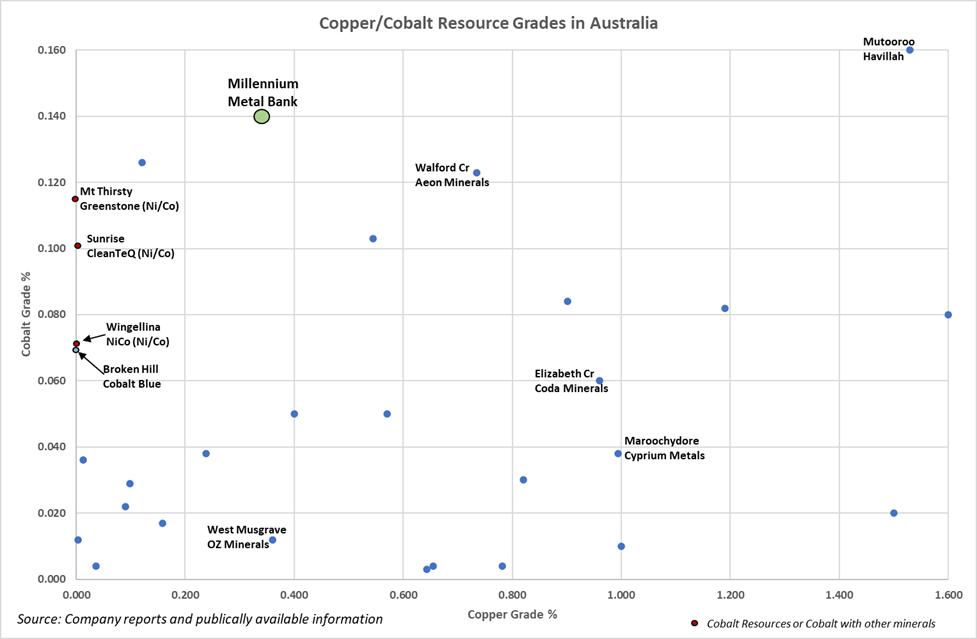
Results for a further four diamond drill (DD) holes and seven reverse circulation (RC) holes including the deep resource drilling and exploration and extension work in the Northern Area are awaited.
In addition, a small Induced Polarisation/resistivity electrical geophysical survey (as utilised to excellent effect at Carnaby Resources and Hammer Metals Cloncurry region projects) was also conducted. This survey aimed to better delineate key structural and geological features to aid drill targeting over untested parts of the project.
Commenting on the results, Metal Bank’s Chair, Inés Scotland said:

“
Great results. Cobalt is recognised as a critical mineral for the production of renewable energy technologies and only yesterday there was significant media coverage regarding the Quad Fund and their charter to invest in Cobalt and Copper companies. The additional near surface extensions in the Central Area are particularly encouraging, and we still waiting on the assay results of the deeper drilling.”
Results from the recently completed drilling program have been received, including one diamond (DD) and five Reverse Circulation (RC) drill holes validating and extending the existing resource (MI22RC04, MI22RC08 11). An additional four DD holes and seven RC holes were also completed as part of the recently completed drilling program, with full assay results expected in the next few weeks. Results are presented in Table 1 and Figure 2, with cross sections in Figures 3 and 4.
HOLE ID FROM INTERVAL (m) Cu % Co % Au g/t
MI22DD01 3.6 0.9 <0.01 <0.01 0.27 and 26 8 0.34 0.08 0.12 and 51 12 0.62 0.14 0.34 MI22RC04 61 3 0.08 0.22 0.03 MI22RC08 39 12 0.53 0.14 0.06 and 52 1 0.12 0.14 0.03 and 55 1 0.22 0.03 0.02
MI22RC09 31 1 0.26 0.02 0.01 and 40 1 2.19 <0.01 0.01 and 43 1 0.23 0.01 <0.01
MI22RC10 31 1 0.24 0.02 <0.01 and 36 1 0.38 <0.01 <0.01
NOTE: 0.2% Cu cut off, 3m maximum internal dilution unless indicated by*. Results >0.1% Co reported individually if Cu above cut off is not present.

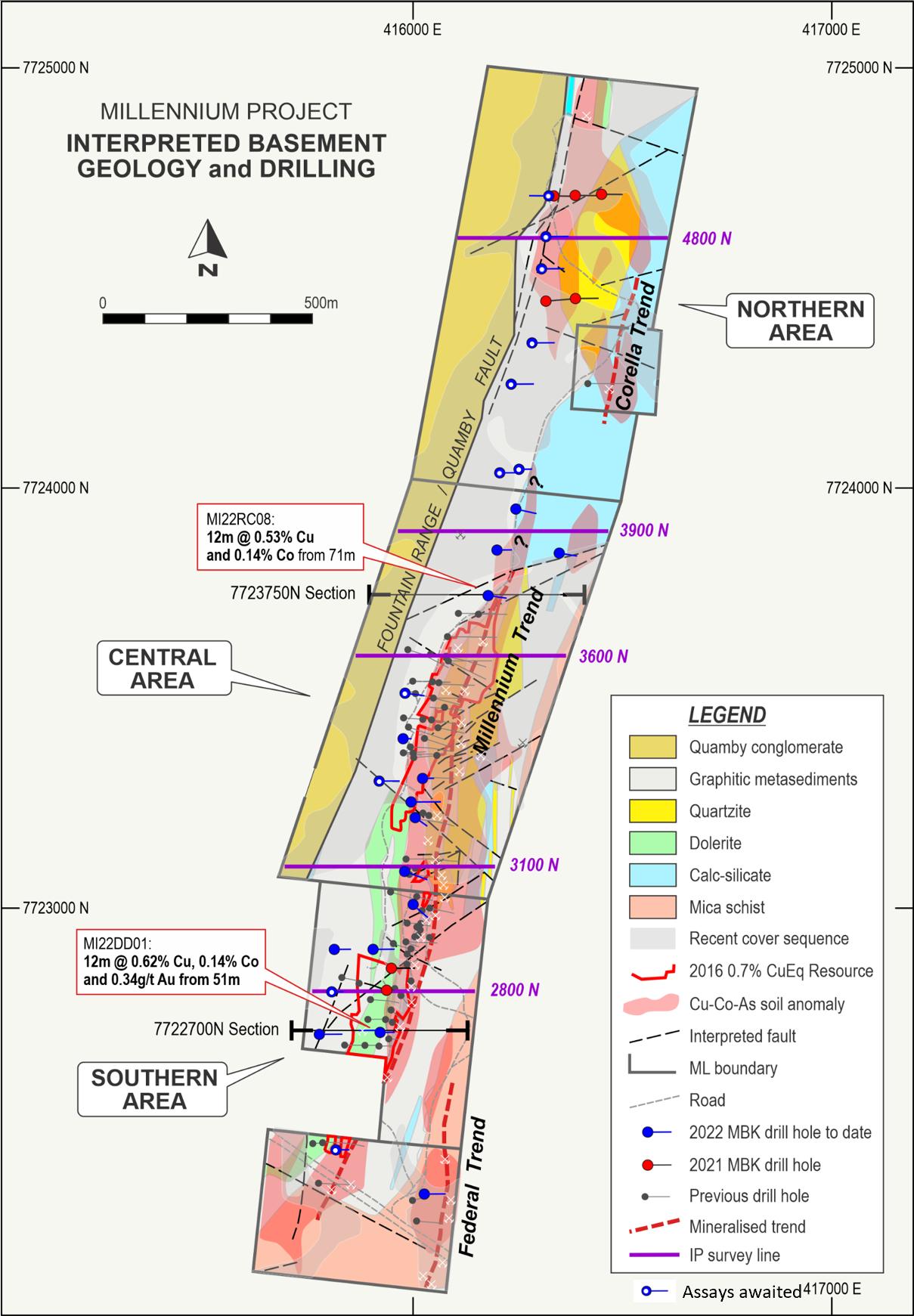
Hole MI22DD01 (metallurgical hole) was targeted into a resource gap. Encouraging results of up to 12m @ 0.62% Cu, 0.14% Co and 0.34g/t Au (Figures 3 and 4) were returned from sheeted veinlet to vein and crackle breccias, with strong Co grades consistent with previous results for the deposit enhanced by low grade Cu and minor oxide Au mineralisation.
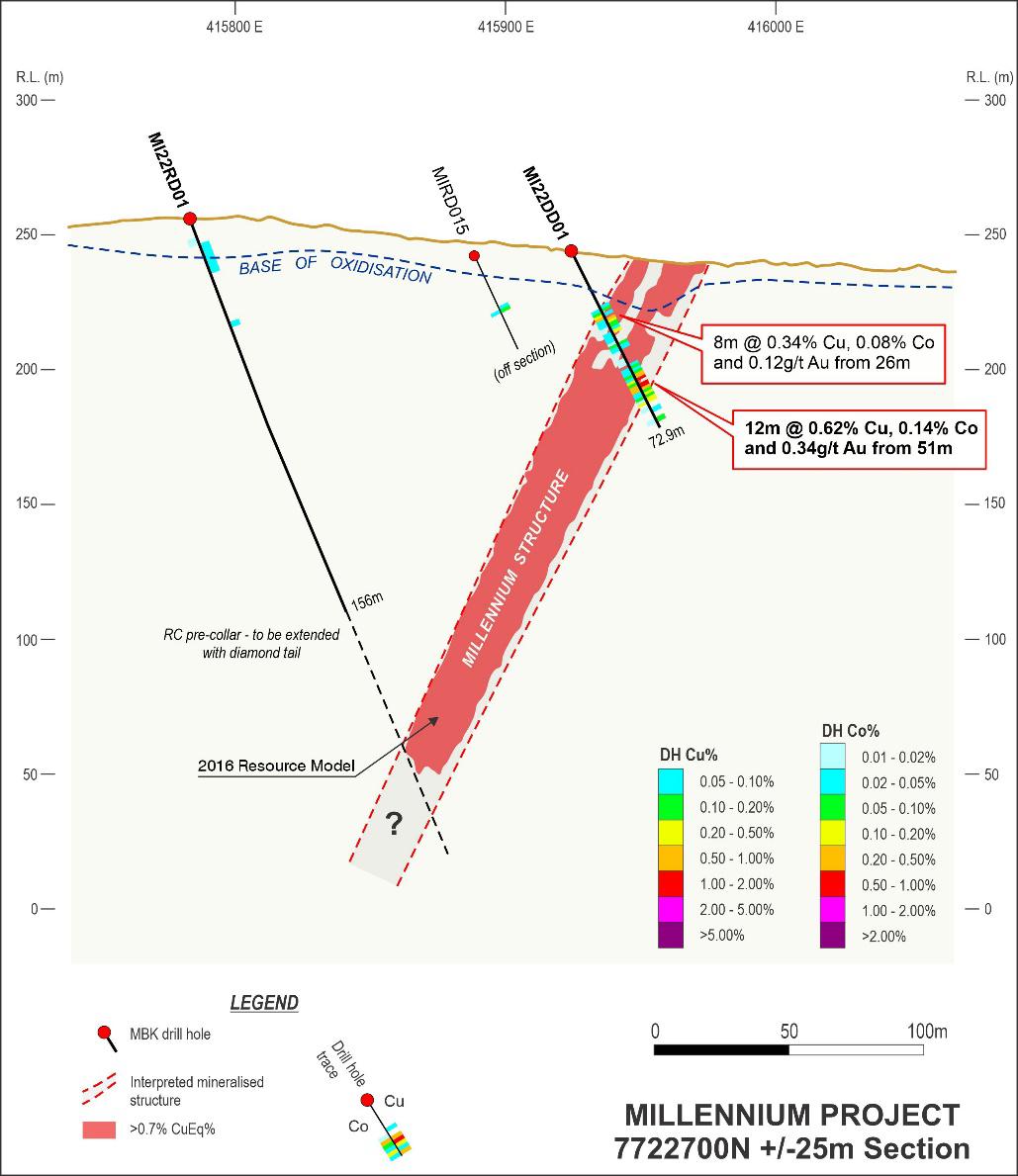

Central Area drilling successfully extended mineralisation 120mnorth of the current resource (refer to Figures 3 and 5). Drill hole MI22RC08 collared north of the current resource, intersected 12m @ 0.53% Cu and 0.14% Co from 39m and drill hole MI22RC09, collared 120m north of MI22RC08 intersected 1m @ 2.19% Cu from 40m Further infill and step out drilling is required in this northern extension to enable for its inclusion in future resource estimates.
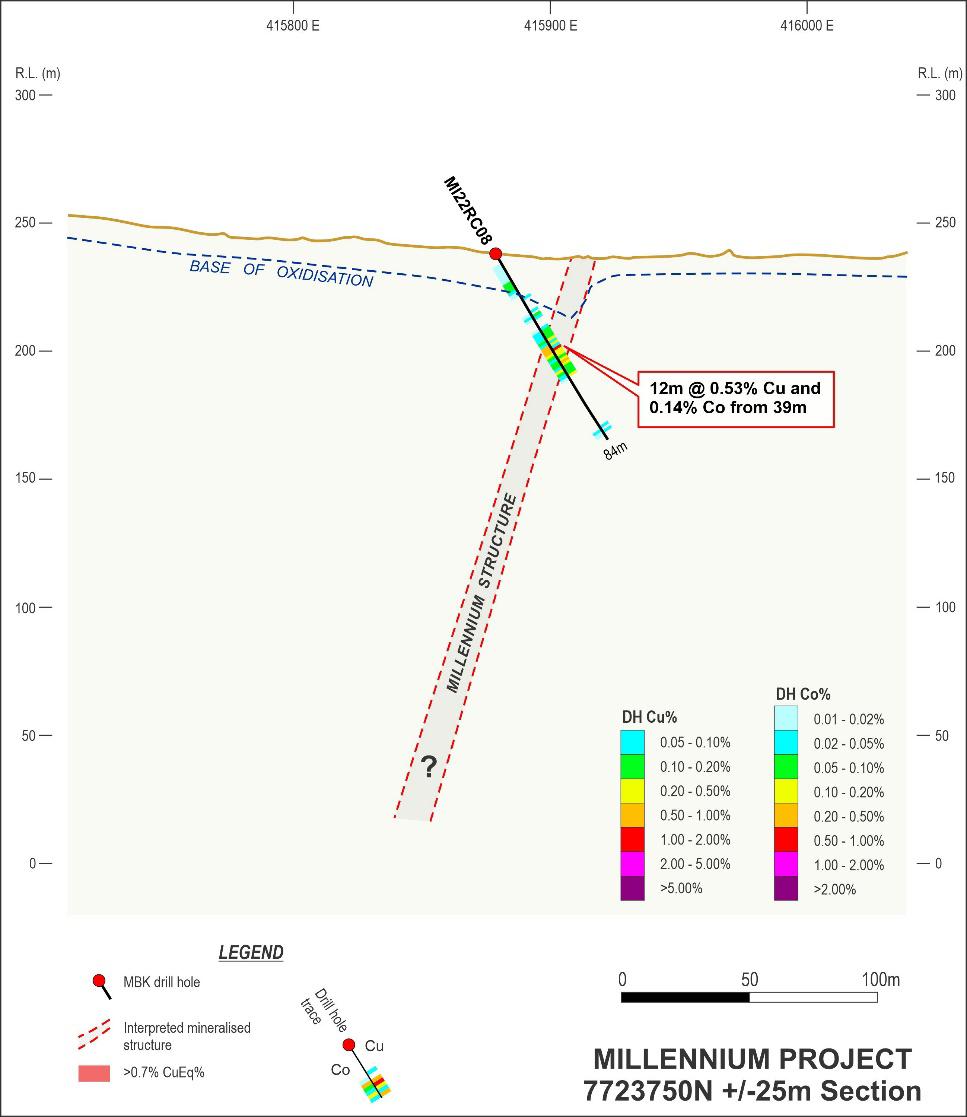

Importantly, broad intervals of prospective alteration and Cu Co+/ Au mineralisation (including high grade Co zones) were intersected in deeper drilling (Figure 6) within the Central Area. Results from these holes are awaited.
Figure 6: MI22RD05, ~179.7m high grade cobaltite rich zone (silver speckles) in strongly altered and deformed calcareous metasediment (HQ core)
Results from the copper dominant Northern Area are awaited. The two northernmost holes aimed at extending the Northern Area mineralisation a further 200m+ north were unable to be completed due to track access issues.
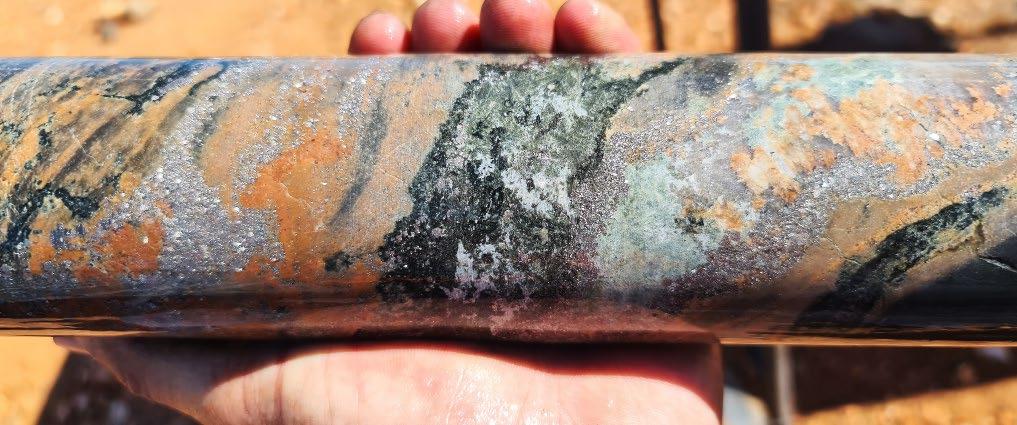

The Pilgrim/Fountain Range/Quamby Fault zone remains an important target for additional new zones of mineralisation, however, the relationship between these structures and Cu Co Au mineralisation at Millennium remains unclear. One scout hole drilled in this program (MI22RC18) was terminated prematurely due to poor ground conditions without intersecting the target fault zone. MBK anticipates initial drill testing of this fault zone in 2023.
Results from a five line pole dipole Induced Polarisation/resistivity electrical geophysical survey (as used to recent success in the area by Carnaby Resources and Hammer Metals) have been received. The survey has been successful in identifying the fault zone hosting Cu Co Au mineralisation which is reflected in the geophysical data as the contrast between areas of high resistivity/low chargeability (hard rocks), and low resistivity/high chargeability (softer rocks). This greatly enhances MBK’s ability to directly target strike extensions of mineralisation at Millennium.

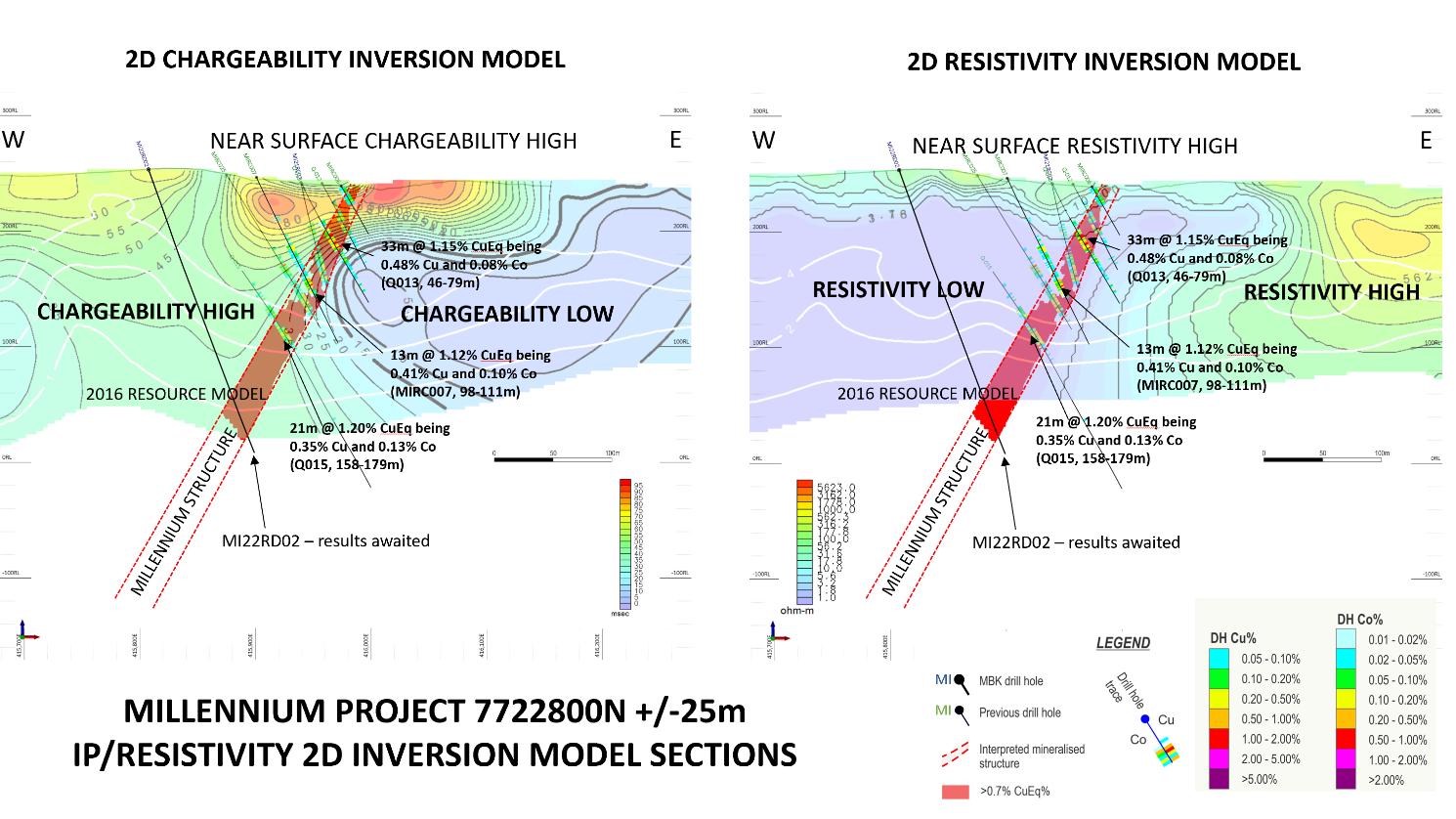

The Millennium Copper and Cobalt Project near Cloncurry in NW QLD currently holds a JORC 2012 compliant Inferred Resource of 5.9Mt @ 1.08% CuEq 2 (Cu Co Au Ag) across 5 granted Mining Leases with significant potential for expansion. It is located 19km from the Rocklands copper cobalt project with an established processing plant capable of treating Millennium style ores once recommissioned.
MBK’s 2021 drill results and other previous drilling, in conjunction with significant appreciation in copper and cobalt prices since maiden Resource reporting, provided support for an initial Exploration Target2 for the Project of 8 10Mt @ 1.0 1.1% CuEq.
MBK developed a three phase work program for Millennium in 2022 3 seeking to confirm the Exploration Target for the Project, and future Resource expansion and development potential. The Exploration Target is based on extensions both along strike and at depth in both the Southern and Central Area copper cobalt gold Resources and in the Northern Area, where shallow copper intervals at broad spacing have been returned some 800 1000m north of the closest Resource.
Upon receipt and assessment of all results from the current 2022 drilling program, MBK will embark on a JORC 2012 compliant Resource update and Scoping Study utilising appropriate economic parameters aimed for completion late 2022.
It should be noted that the Exploration Target is conceptual in nature. There has been insufficient drilling at depth of the existing Resource and in the Northern Area of the project and insufficient information relating to the Reasonable Prospects of Eventual Economic Extraction (RPEEE) of the Millennium project to estimate a Mineral Resource over the Exploration Target area, and it is uncertain if further study will result in the estimation of a Mineral Resource over this area. It is acknowledged that the currently available data is insufficient spatially in terms of the density of drill holes, and in quality, in terms of MBK’s final audit procedures for down hole data, data acquisition and processing, for the results of this analysis to be classified as a Mineral Resource in accordance with the JORC Code.
Authorised by the Board
Metal Bank Limited is an ASX listed minerals exploration company (ASX: MBK) holding a significant portfolio of advanced gold and copper exploration projects with substantial growth upside, including: the right to earn up to 80% of the Millennium Copper & Cobalt project which holds an inferred 2012 JORC resource of 5.9Mt @ 1.08% CuEq 4, across 5 granted Mining Leases with significant potential for expansion; a 75% interest in the advanced Livingstone Gold Project in WA which holds a JORC 2004 Inferred Resource of 49,900oz Au 5 at the Homestead prospect, a JORC 2012 Inferred Resource of 30,500oz 6 Au at Kingsley, and an Exploration Target6 of 290 400Kt at 1.8 2.0 g/t Au for 16,800 25,700oz Au at Kingsley; and the 8 Mile, Wild Irishman and Eidsvold Gold projects in South East Queensland where considerable work by MBK to date has drill proven both high grade vein style and bulk tonnage intrusion related Au mineralisation.
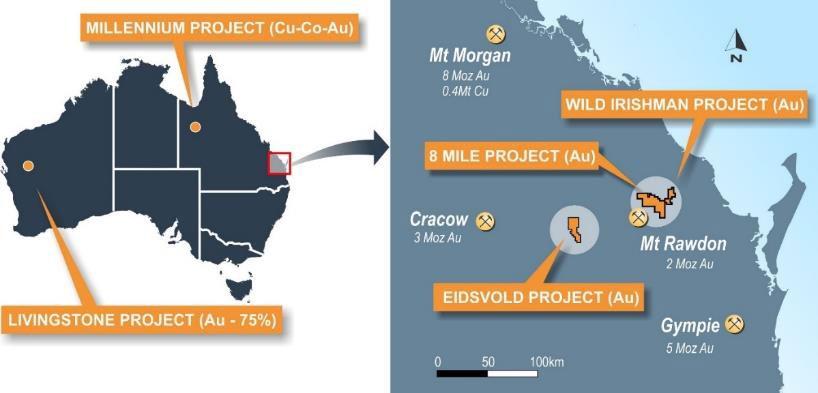

Metal Bank’s exploration programs at these projects are focussed on: short term resource growth advancing existing projects to substantially increase JORC Resources; identifying additional mineralisation at each of its projects; and assessing development potential and including fast tracking projects through feasibility and development to production.
Metal Bank is also committed to a strategy of diversification and growth through identification of new exploration opportunities which complement its existing portfolio and pursuit of other opportunities to diversify the Company’s assets through acquisition of advanced projects or cash flow generating assets to assist with funding of the exploration portfolio.

The information in this announcement that relates to exploration results and Mineral Resources and Ore Reserves for the Millennium Project was prepared and reported in accordance with the ASX Announcements and Global Energy Metals Corporation (GEMC) News Releases referenced in this announcement. The information in this announcement that relates to Mineral Resources of the Millennium Project is based on information compiled by Ms Elizabeth Haren, a Competent Person who is a Member and Chartered Professional of the Australasian Institute of Mining and Metallurgy and a full time employee of Haren Consulting Pty Ltd.
The Company confirms that it is not aware of any new information or data that materially affects the information included in the relevant ASX announcements and News Releases. In the case of Mineral Resource estimates and Ore Reserve estimates, all material assumptions and technical parameters underpinning the estimates continue to apply and have not materially changed. The Company confirms that the form and context in which the Competent Persons’ findings are presented have not been materially modified from the original ASX announcements or News Releases.
The information in this announcement, that relates to MBK Exploration Results, Mineral Resources and Exploration Target statements is based on information compiled or reviewed by Mr Rhys Davies. Mr Davies is a contractor to the Company and eligible to participate in the Company’s equity incentive plan. Mr Davies is a Member of The Australasian Institute of Geoscientists has sufficient experience which is relevant to the style of mineralisation and type of deposit under consideration and to the activity which he is undertaking to qualify as a Competent Person as defined in the 2012 Edition of the ‘Australasian Code for Reporting of Exploration Results, Mineral Resources and Ore Reserves’. Mr Davies consents to the inclusion in this announcement of the matters based on his information in the form and context in which it appears.
It should be noted that the MBK Exploration Targets described in this announcement are conceptual in nature and there is insufficient information to establish whether further exploration will result in the determination of Mineral Resources. As a Cautionary Statement, an Exploration Target is a statement or estimate of the exploration potential of a mineral deposit in a defined geological setting where the statement or estimate, quoted as a range of tonnes and a range of grade, relates to mineralization where there has been insufficient exploration to estimate a Mineral Resource. The potential quantity and grade of the Exploration Targets is conceptual in nature, there has been insufficient exploration to estimate an additional Mineral Resource and it is uncertain if further exploration will result in the estimation of a Mineral Resource. The Exploration Targets take no account of geological complexity that may be encountered, possible mining method or metallurgical recovery factors. It is acknowledged that the currently available data is insufficient spatially in terms of the density of drill holes, and in quality, in terms of MBK’s final audit procedures for down hole data, data acquisition and processing, for the results of this analysis to be classified as Mineral Resources in accordance with the JORC Code.

MI22DD01 415924.4 7722703 243.85 62.5 90 72.9 MI22RC04 415984 7723084 252.29 65 110 133 MI22RC08 416179.2 7723746 238.07 60 90 84 MI22RC09 416201.6 7723855 243.37 60 90 90 MI22RC10 416348.9 7723847 234.38 60 90 90 MI22RC11 416246.8 7723951 242.13 60 90 90

HOLE ID FROM TO INT (m) Cu ppm Co ppm Au g/t
MI22RC04 0 4 4 200 70 0.01 MI22RC04 4 8 4 70 20 0.01 MI22RC04 8 13 5 110 10 0.01 MI22RC04 13 17 4 130 10 0.01 MI22RC04 17 20 3 70 20 0.01 MI22RC04 20 22 2 50 20 0.01 MI22RC04 22 24 2 80 40 0.01 MI22RC04 24 28 4 80 70 0.01 MI22RC04 28 31 3 80 60 0.03 MI22RC04 31 32 1 50 50 0.01 MI22RC04 32 36 4 250 40 0.02 MI22RC04 36 40 4 530 20 0.01 MI22RC04 40 41 1 3180 30 0.01 MI22RC04 41 42 1 850 50 0.01 MI22RC04 42 43 1 790 150 0.01 MI22RC04 43 44 1 2160 470 0.09 MI22RC04 44 45 1 820 290 0.03 MI22RC04 45 46 1 160 100 0.01 MI22RC04 46 47 1 40 50 0.01 MI22RC04 47 48 1 40 40 0.01 MI22RC04 48 49 1 40 50 0.01 MI22RC04 49 50 1 50 90 0.01 MI22RC04
51 1 40 80 0.01 MI22RC04
52 1 50 80 0.01 MI22RC04
1 70 50 0.01 MI22RC04
1 90 50 0.01 MI22RC04
1 80 80 0.01 MI22RC04
1 360 140 0.01 MI22RC04
1 950 170 0.02 MI22RC04
1 570 130 0.01 MI22RC04
1 580 100 0.02 MI22RC04
1 100 470 0.01 MI22RC04
1 260 250 0.01 MI22RC04
1 210 1040 0.01 MI22RC04
1 1390 3640 0.04
MI22RC04 63 64 1 940 1820 0.04 MI22RC04 64 65 1 1070 630 0.03 MI22RC04 65 66 1 110 170 0.01 MI22RC04 66 67 1 60 230 0.01 MI22RC04 67 68 1 350 240 0.01 MI22RC04 68 69 1 30 120 0.01 MI22RC04 69 70 1 40 140 0.01 MI22RC04 70 71 1 40 120 0.01 MI22RC04 71 72 1 60 60 0.01 MI22RC04 72 73 1 40 70 0.01 MI22RC04 73 74 1 60 50 0.01 MI22RC04 74 75 1 30 40 0.01 MI22RC04 75 76 1 50 70 0.01 MI22RC04 76 77 1 50 90 0.01 MI22RC04 77 78 1 50 80 0.01 MI22RC04 78 79 1 100 60 0.01 MI22RC04 79 80 1 300 100 0.01 MI22RC04 80 81 1 530 160 0.01 MI22RC04 81 82 1 410 130 0.01 MI22RC04 82 83 1 200 80 0.01 MI22RC04 83 84 1 180 60 0.01 MI22RC04 84 85 1 130 70 0.01 MI22RC04 85 86 1 250 120 0.01 MI22RC04 86 87 1 100 50 0.01 MI22RC04 87 88 1 410 40 0.01 MI22RC04 88 89 1 160 50 0.01 MI22RC04 89 90 1 240 70 0.01 MI22RC04 90 91 1 360 90 0.01 MI22RC04 91 92 1 180 50 0.01 MI22RC04 92 93 1 140 40 0.01 MI22RC04 93 94 1 120 40 0.01 MI22RC04 94 95 1 110 40 0.01 MI22RC04 95 96 1 110 20 0.01 MI22RC04 96 97 1 270 40 0.01 MI22RC04 97 98 1 410 50 0.01 MI22RC04 98 99 1 320 40 0.01 MI22RC04 99 100 1 310 80 0.01 MI22RC04 100 104 4 390 50 0.01 MI22RC04 104 107 3 180 40 0.01 MI22RC04 107 108 1 380 150 0.01 MI22RC04 108 109 1 540 110 0.01 MI22RC04 109 110 1 200 50 0.01 MI22RC04 110 111 1 240 60 0.01 MI22RC04 111 112 1 160 40 0.01 MI22RC04 112 113 1 100 10 0.01 MI22RC04 113 114 1 70 20 0.01 MI22RC04 114 115 1 50 10 0.01

MI22RC04 115 116 1 90 20 0.01

MI22RC04 116 117 1 40 10 0.01 MI22RC04 117 118 1 40 10 0.01
MI22RC04 118 119 1 40 10 0.01
MI22RC04 119 123 4 70 10 0.01 MI22RC04 123 127 4 40 10 0.01 MI22RC04 127 129 2 80 10 0.01 MI22RC04 129 130 1 110 20 0.01
MI22RC04 130 133 3 50 20 0.01 MI22RC08 0 4 4 270 30 0.01 MI22RC08 4 8 4 230 100 0.04 MI22RC08 8 12 4 280 180 0.02 MI22RC08 12 16 4 240 500 0.05 MI22RC08 16 17 1 70 230 0.02 MI22RC08 17 18 1 180 160 0.01 MI22RC08 18 19 1 110 150 0.04 MI22RC08 19 20 1 210 50 0.01 MI22RC08 20 21 1 580 50 0.01 MI22RC08 21 22 1 200 40 0.01 MI22RC08 22 23 1 220 30 0.01 MI22RC08 23 24 1 390 30 0.01 MI22RC08 24 25 1 230 60 0.01 MI22RC08 25 26 1 330 20 0.02 MI22RC08 26 27 1 570 40 0.01 MI22RC08 27 28 1 270 140 0.01 MI22RC08 28 29 1 1180 280 0.05 MI22RC08 29 30 1 780 120 0.02 MI22RC08 30 31 1 230 50 0.01 MI22RC08 31 32 1 180 30 0.02 MI22RC08 32 33 1 30 20 0.01 MI22RC08 33 34 1 200 60 0.01 MI22RC08 34 35 1 890 130 0.01 MI22RC08 35 36 1 1180 390 0.04 MI22RC08 36 37 1 1100 220 0.03 MI22RC08 37 38 1 1140 220 0.02 MI22RC08 38 39 1 1370 230 0.02 MI22RC08 39 40 1 3950 780 0.09 MI22RC08 40 41 1 860 300 0.06 MI22RC08 41 42 1 4250 2020 0.04 MI22RC08 42 43 1 9570 2060 0.09 MI22RC08 43 44 1 17400 2480 0.18 MI22RC08 44 45 1 4920 4330 0.06 MI22RC08 45 46 1 4770 1010 0.04 MI22RC08 46 47 1 2890 890 0.04 MI22RC08 47 48 1 1800 490 0.02 MI22RC08 48 49 1 2890 620 0.04 MI22RC08 49 50 1 5110 840 0.02
MI22RC08 50 51 1 4800 890 0.04 MI22RC08 51 52 1 1900 450 0.03 MI22RC08 52 53 1 1210 1350 0.03 MI22RC08 53 54 1 1670 620 0.03 MI22RC08 54 55 1 1650 230 0.02 MI22RC08 55 56 1 2200 260 0.02 MI22RC08 56 57 1 340 100 0.01 MI22RC08 57 58 1 230 50 0.01 MI22RC08 58 59 1 180 30 0.01 MI22RC08 59 60 1 130 50 0.01 MI22RC08 60 61 1 120 90 0.01 MI22RC08 61 62 1 180 90 0.01 MI22RC08 62 63 1 110 40 0.02 MI22RC08 63 64 1 80 30 0.01 MI22RC08 64 65 1 330 40 0.01 MI22RC08 65 66 1 90 20 0.01 MI22RC08 66 67 1 30 30 0.01 MI22RC08 67 68 1 30 20 0.01 MI22RC08 68 69 1 20 20 0.01 MI22RC08 69 70 1 20 10 0.01 MI22RC08 70 71 1 30 30 0.01 MI22RC08 71 72 1 80 50 0.01 MI22RC08 72 73 1 40 50 0.08 MI22RC08 73 74 1 90 40 0.01 MI22RC08 74 75 1 210 40 0.01 MI22RC08 75 76 1 220 20 0.01 MI22RC08 76 77 1 190 30 0.01 MI22RC08 77 78 1 60 10 0.01 MI22RC08 78 79 1 320 30 0.01 MI22RC08 79 80 1 650 70 0.02 MI22RC08 80 81 1 460 200 0.01 MI22RC08 81 82 1 660 100 0.02 MI22RC08 82 83 1 300 120 0.01 MI22RC08 83 84 1 60 40 0.01 MI22RC09 0 4 4 150 20 0.01 MI22RC09 4 8 4 160 20 0.01 MI22RC09 8 12 4 340 40 0.01 MI22RC09 12 16 4 270 50 0.01 MI22RC09 16 20 4 290 60 0.01 MI22RC09 20 21 1 330 60 0.01 MI22RC09 21 22 1 530 50 0.01 MI22RC09 22 23 1 260 40 0.01 MI22RC09 23 24 1 310 40 0.01 MI22RC09 24 25 1 310 30 0.01 MI22RC09 25 26 1 330 50 0.01 MI22RC09 26 27 1 340 40 0.01 MI22RC09 27 28 1 290 40 0.01

MI22RC09 28 29 1 250 100 0.01 MI22RC09 29 30 1 650 90 0.01 MI22RC09 30 31 1 430 80 0.01 MI22RC09 31 32 1 2570 160 0.01 MI22RC09 32 33 1 270 20 0.01 MI22RC09 33 34 1 480 70 0.01 MI22RC09 34 35 1 890 110 0.01 MI22RC09 35 36 1 490 80 0.01 MI22RC09 36 37 1 1150 80 0.01 MI22RC09 37 38 1 240 20 0.01 MI22RC09 38 39 1 200 30 0.01 MI22RC09 39 40 1 380 70 0.09 MI22RC09 40 41 1 21900 30 0.01 MI22RC09 41 42 1 1370 30 0.01 MI22RC09 42 43 1 720 60 0.01 MI22RC09 43 44 1 2260 100 0.01 MI22RC09 44 45 1 780 30 0.01 MI22RC09 45 46 1 270 50 0.01 MI22RC09 46 50 4 160 30 0.01 MI22RC09 50 54 4 30 30 0.01 MI22RC09 54 56 2 440 30 0.01 MI22RC09 56 57 1 150 40 0.01 MI22RC09 57 58 1 210 80 0.01 MI22RC09 58 60 2 130 30 0.01 MI22RC09 60 62 2 70 20 0.01 MI22RC09 62 64 2 70 30 0.01 MI22RC09 64 66 2 150 150 0.01 MI22RC09 66 70 4 270 60 0.01 MI22RC09 70 74 4 330 50 0.01 MI22RC09 74 75 1 170 80 0.01 MI22RC09 75 76 1 160 120 0.01 MI22RC09 76 77 1 90 50 0.01 MI22RC09 77 78 1 120 50 0.01 MI22RC09 78 79 1 60 50 0.01 MI22RC09 79 80 1 50 50 0.01 MI22RC09 80 81 1 60 130 0.01 MI22RC09 81 82 1 90 70 0.02 MI22RC09 82 83 1 1060 120 0.01 MI22RC09 83 84 1 50 50 0.01 MI22RC09 84 86 2 120 40 0.01 MI22RC09 86 88 2 280 30 0.01 MI22RC09 88 90 2 290 50 0.01 MI22RC10 0 4 4 120 10 0.01 MI22RC10 4 8 4 390 30 0.01 MI22RC10 8 12 4 390 40 0.01 MI22RC10 12 13 1 460 20 0.01 MI22RC10 13 14 1 970 60 0.01

MI22RC10 14 15 1 1080 70 0.01 MI22RC10 15 16 1 940 100 0.01 MI22RC10 16 17 1 970 100 0.01 MI22RC10 17 18 1 980 80 0.01 MI22RC10 18 19 1 930 120 0.01 MI22RC10 19 20 1 770 120 0.01 MI22RC10 20 21 1 730 110 0.01 MI22RC10 21 22 1 740 40 0.01 MI22RC10 22 23 1 1050 110 0.01 MI22RC10 23 24 1 1280 110 0.01 MI22RC10 24 25 1 830 50 0.01 MI22RC10 25 26 1 970 80 0.01 MI22RC10 26 27 1 1230 110 0.01 MI22RC10 27 28 1 770 70 0.01 MI22RC10 28 29 1 630 90 0.01 MI22RC10 29 30 1 450 60 0.01 MI22RC10 30 31 1 340 50 0.01 MI22RC10 31 32 1 2440 160 0.01 MI22RC10 32 33 1 1050 200 0.01 MI22RC10 33 34 1 660 90 0.01 MI22RC10 34 35 1 760 80 0.01 MI22RC10 35 36 1 860 90 0.01 MI22RC10 36 37 1 3790 30 0.01 MI22RC10 37 38 1 140 10 0.01 MI22RC10 38 39 1 100 10 0.01 MI22RC10 39 40 1 460 100 0.01 MI22RC10 40 41 1 150 30 0.01 MI22RC10 41 42 1 670 30 0.01 MI22RC10 42 46 4 130 20 0.01 MI22RC10 46 50 4 10 10 0.01 MI22RC10 50 54 4 10 10 0.01 MI22RC10 54 58 4 10 10 0.01 MI22RC10 58 62 4 10 10 0.01 MI22RC10 62 66 4 10 10 0.01 MI22RC10 66 70 4 10 10 0.01 MI22RC10 70 72 2 10 10 0.01 MI22RC10 72 73 1 10 10 0.01 MI22RC10 73 74 1 10 10 0.01 MI22RC10 74 75 1 10 10 0.01 MI22RC10 75 76 1 10 10 0.01 MI22RC10 76 80 4 10 10 0.01 MI22RC10 80 84 4 10 10 0.01 MI22RC10 84 88 4 10 10 0.01 MI22RC10 88 90 2 10 10 0.01 MI22RC11 0 1 1 110 10 0.01 MI22RC11 1 5 4 20 30 0.01 MI22RC11 5 9 4 80 30 0.01

MI22RC11
13 4 60 10 0.01 MI22RC11
17 4 40 10 0.01 MI22RC11 17 21 4 120 20 0.01 MI22RC11 21 25 4 190 30 0.01 MI22RC11 25 29 4 50 40 0.01 MI22RC11 29 33 4 10 20 0.01 MI22RC11 33 37 4 10 20 0.01 MI22RC11 37 41 4 10 30 0.01 MI22RC11 41 45 4 20 50 0.01 MI22RC11 45 49 4 10 40 0.01 MI22RC11 49 53 4 10 20 0.01 MI22RC11 53 57 4 10 20 0.01 MI22RC11 57 61 4 10 20 0.01 MI22RC11 61 65 4 10 10 0.01 MI22RC11 65 69 4 100 10 0.01 MI22RC11 69 73 4 10 10 0.01 MI22RC11 73 77 4 10 20 0.01 MI22RC11 77 81 4 10 10 0.01 MI22RC11 81 85 4 10 10 0.01 MI22RC11 85 90 5 10 10 0.01
in this section apply to all
• Nature and quality of sampling (e.g. cut channels, random chips, or specific specialised industry standard measurement tools appropriate to the minerals under investigation, such as down hole gamma sondes, or handheld XRF instruments, etc.). These examples should not be taken as limiting the broad meaning of sampling.
• Include reference to measures taken to ensure sample representivity and the appropriate calibration of any measurement tools or systems used.
• Aspects of the determination of mineralisation that are Material to the Public Report. In cases where ‘industry standard’ work has been done this would be relatively simple (e.g. ‘reverse circulation drilling was used to obtain 1 m samples from which 3 kg was pulverised to produce a 30 g charge for fire assay’). In other cases more explanation may be required, such as where there is coarse gold that has inherent sampling problems. Unusual commodities or mineralisation types (e.g. submarine nodules) may warrant disclosure of detailed information.
• 5.5” Reverse circulation (RC) drilling was used to obtain chip samples for geological logging and assaying.

• PQ and HQ core was used to obtain samples for geological logging, with ¼ PQ and ½ HQ core samples for assay obtained via diamond core saw splitting ensuring representative samples and apexing of veining where possible
• Drill holes were sited to test geophysical targets/surface geochemical and structural targets, resource infill and extension zones
• 1m RC samples were collected via a cyclone mounted rotary splitter for all samples, with the entire sample bagged along with a representative ~1/16th primary split sample off the splitter
• Sample intervals were determined by the rig geologist based on visual observations with all notable RC samples undertaken in 1m intervals, otherwise in 2 4m riffle split composites of the primary split as determined by downhole geology for RC.
• Nominal/maximum 1m sample intervals for DD
• RC and DD samples were submitted to ALS Mt Isa and sample preparation consisted of the drying of the sample, the entire sample being crushed to 70% passing 6mm and pulverized to 85% passing 75 microns in a ring and puck pulveriser. RC and DD samples are assayed for
gold by 50g fire assay with AAS finish. Multielement analysis is completed using an ICPAES analysis.
• Drill type (e.g. core, reverse circulation, open hole hammer, rotary air blast, auger, Bangka, sonic, etc.) and details (e.g. core diameter, triple or standard tube, depth of diamond tails, face sampling bit or other type, whether core is oriented and if so, by what method, etc.).
• Method of recording and assessing core and chip sample recoveries and results assessed.
• Measures taken to maximise sample recovery and ensure representative nature of the samples.
• Whether a relationship exists between sample recovery and grade and whether sample bias may have occurred due to preferential loss/gain of fine/coarse material.
• RC drilling used a 5.5” face sampling RC hammer and a modified Ingersoll Rand track mounted drill rig and a truck mounted 800 series multi purpose drill rig
• Diamond drilling used HQ and PQ size core obtained via a truck mounted 800 series multi purpose drill rig
• For RC sample recoveries of less than approximately 80% are noted in the geological/sampling log with a visual estimate of the actual recovery. Very few samples were recorded with recoveries of less than 80%. No wet RC samples were recovered.
• DD core recovery is accurately measured for recovery by both drillers and as part of geotechnical logging
• Triple tube is used to ensure maximum core sample recovery along with careful technique, adequate drilling products and short runs in broken ground
• No relationship has been observed between sample recovery and grade to date
• Whether core and chip samples have been geologically and geotechnically logged to a level of detail to support appropriate Mineral Resource estimation, mining studies and metallurgical studies.
• Whether logging is qualitative or quantitative in nature. Core (or costean, channel, etc.) photography.
• The total length and percentage of the relevant intersections logged.
• If core, whether cut or sawn and whether quarter, half or all core taken.
• If non core, whether riffled, tube sampled, rotary split, etc. and whether sampled wet or dry.
• For all sample types, the nature, quality and appropriateness of the sample preparation technique.
• Quality control procedures adopted for all sub sampling stages to maximise representivity of samples.
• Measures taken to ensure that the sampling is representative of the in situ material collected, including for instance results for field duplicate/second half sampling.
• Whether sample sizes are appropriate to the grain size of the material being sampled.
• Geological logging is carried out on all RC chips and drill core. This includes lithology, alteration, sulphide percentages and vein percentages.
• Geological logging of alteration type, alteration intensity, vein type and textures, % of veining, and sulphide composition.
• All RC chip trays and all core trays are photographed.
• All drill holes are logged in full.
• Drill core is cut via diamond brick saw cut PQ ¼ core, HQ ½ core

• 1m primary RC samples were obtained using a cyclone mounted 87.5%:12.5% riffle splitter.
• 1m samples were taken in notable or altered/mineralised ground, otherwise composited via riffle splitter as determined by the rig geologist
• Duplicated samples were collected in visual ore zones and at a frequency of at least 1 in 20.
• QAQC samples (standards / blanks) were submitted at a frequency of at least 1 in 20. Regular reviews of the sampling were carried out by the Exploration Manager to ensure all procedures were followed and best industry practice carried out.
• Duplicate DD sampling consisted of laboratory split sub samples of crushed core samples
• Duplicate RC sampling concentrated on potentially mineralised intervals and was undertaken at the rig by riffle splitting bulk primary samples
• The sample sizes, sampling technique and methods are considered to be appropriate for the nature of mineralisation within the project area.
• The nature, quality and appropriateness of the assaying and laboratory procedures used and whether the technique is considered partial or total.
• For geophysical tools, spectrometers, handheld XRF instruments, etc., the parameters used in determining the analysis including instrument make and model, reading times, calibrations factors applied and their derivation, etc..
• Nature of quality control procedures adopted (e.g. standards, blanks, duplicates, external laboratory checks) and whether acceptable levels of accuracy (i.e. lack of bias) and precision have been established.
• DD and RC samples were assayed for Au using 50g Au AA26 fire assay which is considered appropriate for this style of mineralisation. Fire assay is considered total assay for gold.
• Multi element analysis was conducted by standard ME ICP61a protocol and considered appropriate for this style of mineralisation. It is considered a near total assay for most relevant elements
• Monitoring of results of blanks and standards is conducted regularly. QA/QC data is reviewed for bias prior to inclusion in any subsequent Mineral Resource estimate.
• The verification of significant intersections by either independent or alternative company personnel.
• The use of twinned holes.
• Documentation of primary data, data entry procedures, data verification, data storage (physical and electronic) protocols.
• Discuss any adjustment to assay data.
• Accuracy and quality of surveys used to locate drill holes (collar and down hole surveys), trenches, mine workings and other locations used in Mineral Resource estimation.
• Specification of the grid system used.
• Quality and adequacy of topographic control.
• Significant intersections are routinely monitored through review of drill chip and drill core and by site visits when possible by the Exploration Manager.
• Data is verified and checked in Micromine software.
• No drill holes have been twinned.
• Primary data is collected via paper and laptops in the field in self validating data entry forms. Data is subsequently uploaded into a corporate database for further validation/checking and data management. All original files are stored as a digital record.
• No adjustments have been applied to assay data.
• Drill hole collar locations are initially set out (and reported) using a handheld GPS with a location error of +/ 5m.
• Drill hole collar locations are then checked on completion via handheld GPS with +/ 5m accuracy using existing LiDAR and regional DTM data
• Final pickup is done via third party surveyors, with all MBK 2021 and 2022 drill hole data picked up via via RTK DGPS with an estimated accuracy of <5cm
• Down hole surveys were completed using an Eastman film survey tool or Reflex digital survey tool at a maximum interval of 30m.
• All drilling is conducted on the MGA94 Zone 54 grid.
• A complete topographic survey of the project area has not been conducted however LiDAR high resolution coverage is available over the majority of the project area
• Data spacing for reporting of Exploration Results.
• Whether the data spacing and distribution is sufficient to establish the degree of geological and grade continuity appropriate for the Mineral Resource and Ore Reserve estimation procedure(s) and classifications applied.
• Whether sample compositing has been applied.
• Drill holes were sited to test along strike and down dip of previous drilling. Some drill holes have been collared off the same drill pads.
• The current drill hole spacing in some locations is of sufficient density to establish geological and grade continuity appropriate for a Mineral Resource. An updated mineral resource estimate will be considered once further drilling is completed.
• Samples >1m are weighted mean average with a tabled cut off of 0.2% Cu with 3m maximum internal dilution. Co at 0.1% has also been used where appropriate.
• Whether the orientation of sampling achieves unbiased sampling of possible structures and the extent to which this is known, considering the deposit type.
• If the relationship between the drilling orientation and the orientation of key mineralised structures is considered to have introduced a sampling bias, this should be assessed and reported if material.
• The measures taken to ensure
security.
• Drilling is oriented to intersect known and interpreted structures as perpendicular as possible in the XY plane and in the XZ plan as required to either infill spacing vertically as required or transect the structure at best possible true widths
• Samples are delivered via MBK staff directly to ALS Mt Isa laboratory in sealed and zip tied bags and bulk bags

•
• No
have
(Criteria in this section apply to all succeeding sections.)
• Type, reference name/number, location and ownership including agreements or material issues with third parties such as joint ventures, partnerships, overriding royalties, native title interests, historical sites, wilderness or national park and environmental settings.
• The security of the tenure held at the time of reporting along with any known impediments to obtaining a licence to operate in the area.
• The Millennium project consists of 5 granted ML’s 2512, 2761, 2762, 7506 and 7507 which is 100% owned by Global Energy Metals Corporation (GEMC), a TSX listed Canadian diversified battery metals company. Metal Bank Limited (MBK) has recently entered into a formal option agreement with GEMC to earn up to 80% of the project

• A review of environmental maps at the time of application did not identify any significant environmental restricted areas.
• Acknowledgment and appraisal of exploration by other parties.
• Deposit type, geological setting and style of mineralisation.
• Several exploration companies have completed exploration work at Millennium in recent years including China Yunnan and Hammer Metals.
The MLs lie on the Cloncurry 1:100,000 map sheet. The Millennium Project is situated in the Quamby Malbon Sub province of the Eastern Succession of the Mt. Isa Inlier and lies within the predominantly metasedimentary Corella Formation of the Mary Kathleen Group
The metasedimentary rocks locally comprise Milo Beds of the Tommy Creek Domain containing Palaeoproterozoic Cover Sequence 3 sediments and felsic and mafic igneous rocks with geochronological ages ranging from 1660 to 1610 Ma. The domain is underlain by Cover Sequence 2 Corella Formation belonging to the Mary Kathleen Domain (west) and Canobie Domain (east).
The western margin is bordered by the Fountain Range/Quamby Fault system, a regionally extensive NNE trending, dextral strike slip fault system that demarcates the Tommy Creek Domain from the Mary Kathleen Domain. A block of Quamby Conglomerate is situated immediately west of the Milo Beds, bound between the Quamby Fault to the east and the Fountain Range Fault to the west.
In the vicinity of the Millennium Project area, the Fountain Range Fault has merged with the Pilgrim Fault, a regionally extensive NNE trending, reverse to dextral strike slip fault system that hosts numerous mineral occurrences including the Kalman Cu, Au, Mo, Re deposit and the Tick Hill Au occurrences. The Pilgrim Fault is interpreted as an east dipping fault with a surface expression of multiple stacked east stepping, steeply west dipping shears.
Drill hole information
• A summary of all information material to the understanding of the exploration results including a tabulation of the following information for all Material drill holes:
o easting and northing of the drill hole collar
o elevation or RL (Reduced Level elevation above sea level in metres) of the drill hole collar
o dip and azimuth of the hole
o down hole length and interception depth
o hole length.
• In reporting Exploration Results, weighting averaging techniques, maximum and/or minimum grade truncations (e.g. cutting of high grades) and cut off grades are usually Material and should be stated.
• Where aggregate intercepts incorporate short lengths of high grade results and longer lengths of low grade results, the procedure used for such aggregation should be stated and some typical examples of such aggregations should be shown in detail.
• The assumptions used for any reporting of metal equivalent values should be clearly stated.
• Unless specified otherwise, a nominal 0.2% Cu lower cut off has been applied incorporating up to 3m of continuous internal dilution below the reporting cut off grade and minimum 1m downhole width used to highlight zones of mineralisation. Refer Table 2.
• Where Cu is not present, a 0.1% Co value has been applied and reported independently
• Where Cu and Co are not present, a 0.5g.t Au cut off has been applied and reported independently
• No metal equivalent values have been used for reporting MBK exploration results.
• These relationships are particularly important in the reporting of Exploration Results.
• If the geometry of the mineralisation with respect to the drill hole angle is known, its nature should be reported.
• If it is not known and only the down hole lengths are reported, there should be a clear statement to this effect (e.g. ‘down hole length, true width not known’).
• Appropriate maps and sections (with scales) and tabulations of intercepts should be included for any significant discovery being reported These should include, but not be limited to a plan view of drill hole collar locations and appropriate sectional views.
• Where comprehensive reporting of all Exploration Results is not practicable, representative reporting of both low and high grades and/or widths should be practiced to avoid misleading reporting of Exploration Results.
• Other exploration data, if meaningful and material, should be reported including (but not limited to): geological observations; geophysical survey results; geochemical survey results; bulk samples size and method of treatment; metallurgical test results; bulk density, groundwater, geotechnical and rock characteristics; potential deleterious or contaminating substances.
• The nature and scale of planned further work (e.g. tests for lateral extensions or depth extensions or large scale step out drilling).
• Diagrams clearly highlighting the areas of possible extensions, including the main geological interpretations and future drilling areas, provided this information is not commercially sensitive.
• A CuEq% was utilised by Hammer Metals in the 2016 resource estimate with the following commodity prices: Cu: US$4,600/t; Co: US$27,000/t; Au: US$1,330/oz; and Ag: US$20/oz
•
Downhole observation results are listed only and interpreted as approximately 70 75% true width
• The internal geometry of the mineralisation and grade distribution is not known in enough detail to determine the true width of the mineralisation.
• However, in most cases a clear gross intersection angle between known mineralised structural corridor and drill hole orientation allows a reasonable estimation of interval true width should mineralisation match
• Refer Table 1.
• Refer to figures contained within this report showing the regional location of the drill holes and cross sections.
• All results are presented in figures and tables contained within this report.
• No other material data collected by Metal Bank Limited is presented in this report.
• Further interpretation and review of the data will be completed in conjunction with upcoming drilling.
